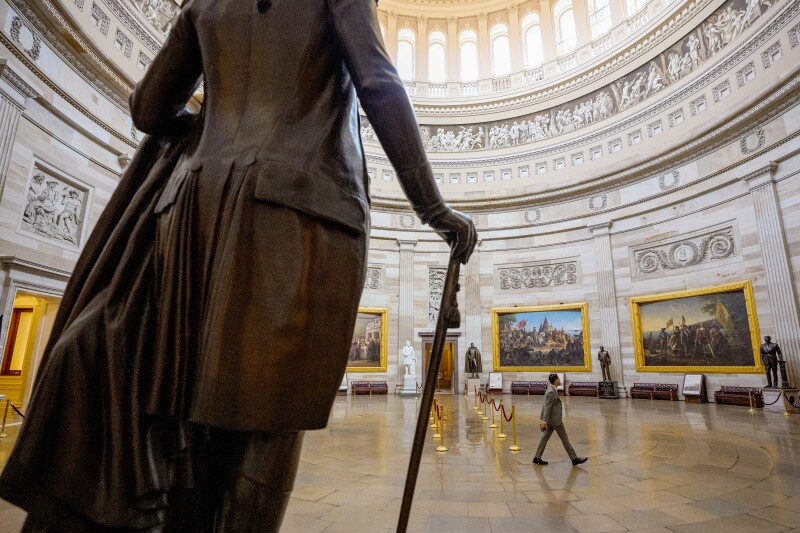Politics
U.S. Treasury Reports $1.8 Trillion Deficit, Debt Soars

The U.S. Treasury Department’s latest report highlights a significant fiscal challenge for the country, revealing a budget deficit of $1.8 trillion for the fiscal year 2025. The government spent over $7 trillion while collecting only $5.2 trillion in taxes. This gap poses a considerable risk, representing more than a quarter of public spending and approximately 6% of the gross domestic product (GDP).
As Congress grapples with pressing issues, including the latest government shutdown, the urgency of this fiscal crisis remains largely unaddressed. The Congressional Budget Office (CBO) has projected that the federal debt will continue to escalate over the coming decades. If current laws remain unchanged, the debt-to-GDP ratio, already at a historic high of around 100%, is expected to surpass 150% in the future.
Debt Projections Raise Concerns
The implications of these projections are alarming. Should future interest rates rise beyond current assumptions—by 5 basis points annually—the debt-to-GDP ratio could exceed 200%. Furthermore, if revenue and spending revert to historical norms, the debt ratio may soar to 225% by 2050, with estimates suggesting it could be “off the chart” by 2055.
Warning signs are evident, as three major federal trust funds are nearing insolvency. The Highway Trust Fund, supported by gas taxes, is projected to be depleted by 2028. Both the Social Security retirement fund and the Medicare hospital-insurance fund are on track to run out by 2032. If these funds are exhausted, federal regulations would necessitate drastic cuts: 46% to highway spending, 24% to Social Security payments, and 12% to Medicare payments.
While there is a tendency for Congress to overlook these mandates and allow the debt to continue accumulating, this approach may eventually lead lenders to question the full repayment of loans, resulting in elevated interest rates. Additional pressures on interest rates stem from demographic shifts, with a rising ratio of dependents to workers, as well as increased demands for investment in defense and clean energy.
Immediate Action Needed
The current budget gap is substantial, and finding a straightforward solution is increasingly complex. To stabilize the debt at 100% of GDP would require reducing the deficit from $1.8 trillion to approximately $1.3 trillion. This would necessitate annual tax increases or spending cuts totaling around $500 billion, equivalent to a universal tax hike of 10%.
Stabilizing the debt at this level is not a viable long-term solution, as it would leave no fiscal room to respond to economic downturns or other emergencies. Each passing year without decisive action exacerbates the problem, making it critical for the White House and Congress to acknowledge the severity of the situation.
A strategic approach that combines spending restraint and higher taxes is essential to address the looming fiscal crisis. Even a moment’s serious consideration of these strategies would represent a significant step forward in tackling these pressing financial challenges.
This editorial reflects the views of the Bloomberg Opinion Editorial Board. Feedback can be sent to [email protected].
-

 World3 weeks ago
World3 weeks agoGlobal Air Forces Ranked by Annual Defense Budgets in 2025
-

 World3 weeks ago
World3 weeks agoMass Production of F-35 Fighter Jet Drives Down Costs
-

 Top Stories3 weeks ago
Top Stories3 weeks agoNew ‘Star Trek: Voyager’ Game Demo Released, Players Test Limits
-

 Science3 weeks ago
Science3 weeks agoTime Crystals Revolutionize Quantum Computing Potential
-

 Top Stories3 weeks ago
Top Stories3 weeks agoDirecTV to Launch AI-Driven Ads with User Likenesses in 2026
-

 World3 weeks ago
World3 weeks agoElectrification Challenges Demand Advanced Multiphysics Modeling
-

 Lifestyle3 weeks ago
Lifestyle3 weeks agoLia Thomas Honored with ‘Voice of Inspiration’ Award at Dodgers Event
-

 Entertainment3 weeks ago
Entertainment3 weeks agoFreeport Art Gallery Transforms Waste into Creative Masterpieces
-

 Lifestyle3 weeks ago
Lifestyle3 weeks agoDiscover Reese Witherspoon’s Chic Dining Room Style for Under $25
-

 Health3 weeks ago
Health3 weeks agoGavin Newsom Critiques Trump’s Health and National Guard Plans
-

 Entertainment3 weeks ago
Entertainment3 weeks agoFast & Furious Coaster Hits the Track at Universal Studios
-

 Politics6 days ago
Politics6 days agoLanguage Evolution: New Words Spark Confusion in Communication









